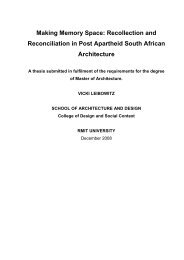Objects in Flux - RMIT Research Repository - RMIT University
Objects in Flux - RMIT Research Repository - RMIT University
Objects in Flux - RMIT Research Repository - RMIT University
You also want an ePaper? Increase the reach of your titles
YUMPU automatically turns print PDFs into web optimized ePapers that Google loves.
<strong>Objects</strong> <strong>in</strong> <strong>Flux</strong><br />
61/ A ‘z<strong>in</strong>e’ or ‘fanz<strong>in</strong>e’ is a small<br />
magaz<strong>in</strong>e-style publication with lim-<br />
ited circulation, generally f<strong>in</strong>anced,<br />
pr<strong>in</strong>ted (often on a black and white<br />
photocopier) and distributed by the<br />
author/editor (Duncombe, 1997;<br />
Triggs, 2006).<br />
62/ A position advanced by Fred<br />
Turner <strong>in</strong> From counterculture to cy-<br />
berculture: Stewart Brand, the Whole<br />
Earth Network, and the Rise of Digital<br />
Utopianism (2006). Turner shows how<br />
Brand and the Whole Earth network<br />
developed connections between San<br />
Francisco’s counterculture movement<br />
and key <strong>in</strong>dividuals with<strong>in</strong> Silicon<br />
Valley’s emerg<strong>in</strong>g technology hub,<br />
actively promot<strong>in</strong>g a vision of the In-<br />
ternet as a transformative, democrat-<br />
is<strong>in</strong>g space.<br />
63/ Triggs regards the punk music<br />
scene as the place where DIY became<br />
a recognisable subculture (2006).<br />
64/ Mary Celeste Kearney cites Rough<br />
Trade’s Geoff Travis as argu<strong>in</strong>g that<br />
‘the <strong>in</strong>dependent DIY ethos thought<br />
by many to be a purely punk <strong>in</strong>spi-<br />
ration, actually came later <strong>in</strong> other<br />
forms of music; ‘When we started<br />
our own record label… it wasn’t punk<br />
but post-punk… and women’s music:<br />
Kleenex, the Ra<strong>in</strong>coats’’ (1997, pp.<br />
214-215).<br />
74<br />
the privileg<strong>in</strong>g of <strong>in</strong>dividual agency and self-determ<strong>in</strong>ation. Active<br />
resistance, conceived through a DIY ethos (particularly with<strong>in</strong> the<br />
post-punk movement), 64 shaped punk’s relation to everyth<strong>in</strong>g from<br />
music production, distribution and performance to fanz<strong>in</strong>es, cloth<strong>in</strong>g,<br />
hous<strong>in</strong>g (squatt<strong>in</strong>g) and anarchist politics.<br />
DIY attitudes found <strong>in</strong> punk and related subcultures became prom<strong>in</strong>ent<br />
<strong>in</strong> protest groups of the 1980s and ’90s, particularly with<strong>in</strong> the<br />
UK where the Anti-Poll Tax campaign <strong>in</strong> the late ’80s and the road<br />
protest camps of the ’90s saw the adoption of direct action and the<br />
DIY ethos as a means to <strong>in</strong>fluence social events (McKay, 1998, p.<br />
6). In speak<strong>in</strong>g of the similarities between DIY culture (understood<br />
through the lens of 1990s political activism) and counterculture<br />
movements of the 1960s, McKay cites ‘a comb<strong>in</strong>ation of <strong>in</strong>spir<strong>in</strong>g<br />
action, narcissism, youthful arrogance, pr<strong>in</strong>ciple, ahistoricism, <strong>in</strong>dulgence,<br />
creativity, plagiarism, as well as a rejection and embrac<strong>in</strong>g<br />
alike of technological <strong>in</strong>novation’ (1998, p. 2). For many participants,<br />
the value of DIY culture ‘lies not <strong>in</strong> “the effect” of long-term<br />
strategy to br<strong>in</strong>g about political goals, but <strong>in</strong> itself as an act of noncompliance,<br />
an act of authenticity to one’s own beliefs’ (Corr<strong>in</strong>e and<br />
Bee cited <strong>in</strong> McKay, 1998, p. 6).<br />
For over a century DIY practices have ‘enabled the consumer to rail<br />
aga<strong>in</strong>st the prescribed design edicts and … social mores of the time’<br />
(Atk<strong>in</strong>son, 2006, p. 9). Whether this be through a democratisation of<br />
luxury goods (Jackson, 2006) or the wholesale rejection of consumer<br />
culture, the political dimension to DIY suggests that practices may<br />
be arranged accord<strong>in</strong>g to their transformative potential. 65 Such an<br />
arrangement presents a field of activity distributed between two<br />
dist<strong>in</strong>ct poles: on the one hand, the commercially facilitated DIY activities<br />
of home ma<strong>in</strong>tenance and renovation, on the other, a diverse<br />
and often outspoken collection of practitioners <strong>in</strong>clud<strong>in</strong>g political<br />
activists, <strong>in</strong>die/alternative musicians, writers, publishers, hobbyists<br />
and ‘makers’ 66 for whom DIY is an everyday revolutionary act. This<br />
distribution may go some way toward account<strong>in</strong>g for participant<br />
motivation and <strong>in</strong>dividual agency, however care must be taken not<br />
to assume that commercially facilitated and <strong>in</strong>stitutionalised DIY<br />
practices are devoid of mean<strong>in</strong>gful participant action. De Certeau<br />
clearly demonstrates that consumers f<strong>in</strong>d countless ways of us<strong>in</strong>g the
















